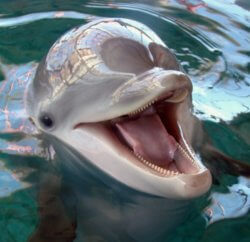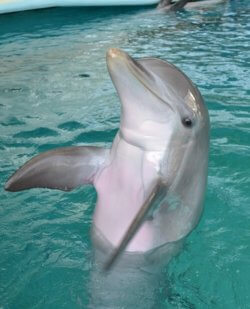By Lori Marino
This week a new scientific paper was published in PLoS One by Rachel Morrison and Diana Reiss showing that two captive-born juvenile bottlenose dolphins, Bayley and Foster, living at the National Aquarium, can recognize themselves in a mirror.
The ability to recognize oneself in a mirror is an indicator of self-awareness – that is, a sense of an autobiographical “I”, as in “That’s me in the mirror.” This level of self-awareness is the basis for the ability to reflect upon and think about oneself and one’s circumstances in a subjective manner. It is a very advanced cognitive capacity that, beyond dolphins, has only been observed in great apes, elephants, magpies and humans over two and a half years old.
In 2001, Diana and I co-authored the first peer-reviewed paper to demonstrate mirror self-recognition in dolphins. And today, I’m gratified to see our seminal finding replicated and published in a peer-reviewed journal. The new findings confirm and extend those original conclusions, and we now know more about how this capacity unfolds in dolphins developmentally.
Our earlier paper showed that two captive-born bottlenose dolphins – Presley, age 13, and Tab, age 17, living at the New York Aquarium in Coney Island – independently demonstrated mirror self-recognition, providing the first evidence for this capacity in a non-primate species. Tab and Presley shot to fame in the press and became members of a club of cetacean “research superstars” who had been shown to exhibit other cognitive abilities like language comprehension and metacognition.
The suffering and death of these two dolphins led to my decision to no longer participate in research on captive animals.Back in 2001, as I began to let our own findings sink into my consciousness, I began to realize the deeper significance of what Diana and I had just shown: namely that two self-aware beings had been spending their entire lives swimming in circles in a small dingy barren tank in Brooklyn. A few years later, Presley and Tab were transferred to other captive facilities, where they would meet untimely deaths from diseases related to stress, immune system dysfunction, and infection. Presley succumbed to fungal encephalitis at age 19 and Tab to gastroenteritis at 21.
The suffering and death of these two dolphins with whom I had worked so closely led to my decision to no longer participate in research on captive animals. I knew that there would be a personal cost to this since our findings had raised so many burning questions that more research would be able to explore. But finding self-recognition and all the other results from captive research only made it glaringly obvious that these animals do not belong in tanks.


Bayley (left) and Foster – Courtesy National Aquarium.
Now, 17 years later, I’m pleased to see that our original scientific findings have been confirmed. But I’m even more delighted to know that Bayley and Foster, the two subjects of this research, will not meet the same fate as Presley and Tab. As members of a group of dolphins at the National Aquarium in Baltimore, they are being prepared for a remarkable new life. The National Aquarium, under the direction of its very progressive CEO, John Racanelli, is creating a permanent seaside sanctuary where all the aquarium’s dolphins will be able to flourish in an environment that’s as close as possible to life in the wild.
The significance of the present work by Morrison and Reiss to our scientific knowledge cannot be over-stated. But its relevance as an example of our ethical evolution is even more important. That’s because it demonstrates that scientific findings have ethical implications.
What I learned from our research back in 2001 led me to what is now the work of the Whale Sanctuary Project, so that other cetaceans – specifically captive orcas and belugas – can be provided with a life that complements their psychology.
It is time for all of us to move beyond the confines of the concrete “dolphin lab” and into a realm that reflects our own findings about who these beings are.
4 Comments
I meet Presley around 1988 when he was one year old. He and his mother, Pricilla, were put in the petting pool at Sea World San Diego. I road the bus there after work almost every day to play with the dolphins. The regulars, like me, called him Elvis. He was the most beautiful dolphin I’d ever seen. But he was a rascal and would get “spanked” by his elders. They would grate their teeth on him to correct his wild, juvenile behavior. So he became very scratched up. Elvis loved to play with me and he was my absolute favorite. I’d pop down below the wall, move over and pop up somewhere else. One time I stood up and he was gone. Then I looked at the bottom of the pool. He was on his side looking up. He loved the touch of my long hair on his nostrum. He and Pricilla were sent to Sea World Houston when he was about 3 years old. I never saw him again. But often searched for him online. He was sent to several places including being trained in a show in Florida. The trainer said he was a brat. He was. I’m so grateful to have known him and the other dolphins and pilot wakes. I’m so devastated to have seen how more and more chlorine was used over the years. The dolphins had coatings on their eyes and kept them shut when I went back years later. I cried and cried when I heard he died. I’d love photos of him.
Dolphin is a wonderful animal. It is a kind of mammal which lives on water. They are very attractive animal which draws so many interest of the tourist all over the world. Watching them personally gives an honor because it is very rare and very hard to find them without spending enough money. Seeing them means that you are financially capable. Unless you are lucky enough to live in a place near dolphin sanctuary haven.
Ditto!
Your insights into the consequences of your very valuable work with dolphins and whales is impressive. I am even more impressed by your admission of your personal decision to no longer work with confined animals. Bravo!